DataMigrator Setup
|
How to: |
|
Reference: |
In addition to providing a graphical interface for designing flows, the DMC can also be used to perform the major setup and administrative tasks.
Note: When you install a Windows server on a computer where you are building flows, the DMC is installed automatically. For other server types or for access to remote Windows servers, the DMC must be installed separately.
Reference: WebFOCUS Environments
The DMC allows you to configure the mid-tier environment for a WebFOCUS Server.
Reference: Requirements for Installing the Data Management Console
To install the DMC, you need the following:
- Pentium 550 mHz processor or higher.
- 400 MB of hard disk space.
- 512 MB of RAM.
- SVGA or higher resolution graphics card set to at least 800 x 600 pixels and high color (16 bit). (The preferred setting is 1024 x 768, with a color depth of 16 bits.)
- A mouse or compatible pointing device supported by Windows.
- A network (TCP/IP) connecting to the DataMigrator Server.
- Windows Vista, 7, 8.1, 10, or Server 2012.
Procedure: How to Install the Data Management Console
- Close any open programs.
- Unzip
the iserver.zip file to a directory on your hard drive. In Windows Explorer,
navigate to the directory and run setup.exe.
The setup program begins and the InstallShield Wizard opens.
- In the
Choose Setup Language window, select a language and click Next.
The License Registration window opens.
- Enter
your license key in the corresponding field. Your license key is found
on the packing slip you received with your iWay 77 Data Management
Tools CD. Click Next.
The InstallShield Wizard displays the License Agreement. Click Yes.
- The InstallShield
Wizard displays the Select the Program Folder and Standard Location
Prompt dialog box, as shown in the following image.
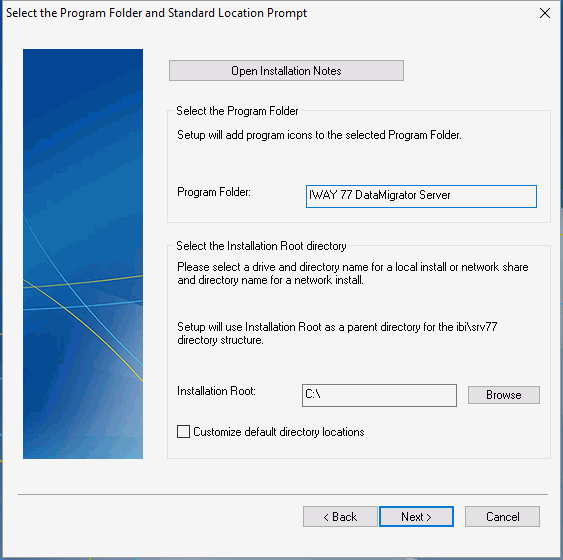
- The default Program Folder name, as it will appear in the Windows Start menu, is IWAY 77 Client. If you wish to use a different folder name, type it here. (You can also choose a folder from the Existing Folders list.)
- Accept
the default root and product configuration directories, or browse to
directories in which you prefer to install your software. Click Next.
The Configure Basic Server Information dialog box opens.
- When
you install the software, you can set up communication to a server.
When you start the software, the server you identify here appears
in the Server list in the navigation pane. The following image shows
the Configure Basic Server Information dialog box.
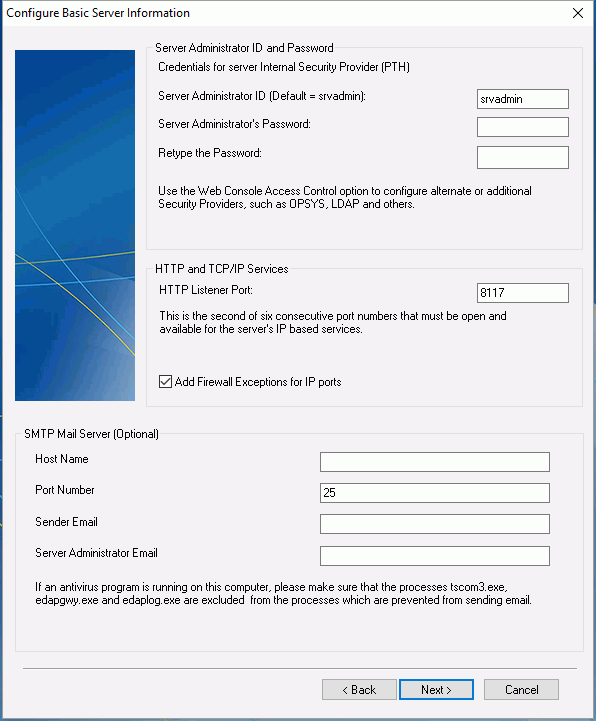
- If you enter a user ID and password in the Server Administrator ID and Password boxes, the iWay client saves the entries, setting security to Explicit by default. You will not be prompted for them again from the DMC. This step is optional.
- In the HTTP
Listener box, enter the port number of the DataMigrator Server.
If you used the defaults when you installed your DataMigrator Server,
the HTTP Listener port number is 8117.
Note: The server will use a group of six ports, starting one less than the port entered here.
- In the Host Name box, type the computer name or IP address where the DataMigrator Server is running.
- Click Next.
Review the selected installation parameters listed.
- Click Continue.
Files are copied to the designated locations. Percent of progress is noted during this process.
Informational messages indicate that setup is configuring the product based on your specifications and that the program folder and icons are being created.
- Optionally, you can start the DataMigrator Server and Web Console, or start the Data Management Console as soon as the installation is complete.
- Click Finish.
Procedure: How to Launch the Data Management Console and Connect to a Server
Note: For non-Windows server installations, the DMC can be found in iWay Software\iWay 77 DM Client\Data Management Console. For Windows server installations, the DMC can be found in iWay Software\iWay 77 DataMigrator Server\Data Management Console.
- On a Windows system, click the Start menu, and click Programs. If using Windows 10, click All Apps.
- Click iWay Software (or Information Builders, if you have a WebFOCUS server installation), then iWay
77 DM Client\Data Management Console or iWay 77 DataMigrator
Server\Data Management Console.
The DMC opens with the available servers listed in the navigation pane on the left.
- Right-click the server you wish to use and click Connect.
If you have not entered connection information, the DMC login dialog box opens. Enter the credentials in the fields provided.
- If your server has security enabled, type your user ID and password in the
User Name and Password fields. If you are connecting with a domain
user ID, select the domain from the drop-down menu.
Windows requires that your user name be no longer than 32 characters.
Note: If you select Save credentials, you do not need to enter these credentials each time you connect, and the dialog box does not appear. However, you must reenter this information when you change your password for the server. To do so, right-click the server name in the navigation tree and click Properties to reopen the Remote Server Configuration dialog box.
- Click Connect.
For data retrieval and processing to occur, you must perform this connection step each time you start the DMC.
Procedure: How to Add a Node to Identify the Server to the Data Management Console
You can set up the DMC to connect to any number of servers in your enterprise.
When the DMC opens for Windows servers, the default LOOPBACK node is listed under Servers in the navigation pane. It does not appear if you open the DMC from a non-Windows installation.
Warning: Do not delete the LOOPBACK node, since it is required for internal processing.
To add another server node in this location:
- Right-click Servers and
click Add Server Node.
The Server Node Configuration dialog box opens, as shown in the following image.
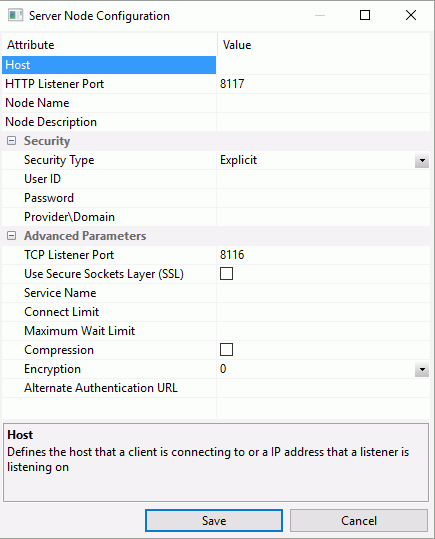
Note: The DMC connects to server nodes using an HTTP listener port and the properties specified in the Host section. Applications that connect using the EDA API, like Resource Analyzer/Governor, use a TCP listener port and the properties specified in the Advanced Parameters section.
- In the Host box, type the computer name or IP address where the DataMigrator Server is running. For a server running on the same PC as the client, you can type localhost.
- In the HTTP Listener Port box, enter the port number of the DataMigrator Server, which is 8117 if you used the installation defaults. This port listens to all incoming requests from the DMC and the Web Console.
- In the Node Name box, type a name for the Server node you wish to add.
- Optionally, type a description of the node in the Node Description box.
- Optionally, use a Secured Sockets Layer (SSL) by selecting that check box in the Advanced Parameters section.
- Security
is set to Explicit by default. When this setting
is in effect, the User ID and password you used to log on to Windows
are not passed to the server. If security is required, you must
enter it either at connection time or in the Security credentials
fields to the right.
Alternatively, for servers running on Windows, you can choose IWA (Integrated Windows Authentication), which passes the Windows User ID and password to the server when a connection is made.
- Click OK.
The node is added to the Servers tree, as shown in the following image.
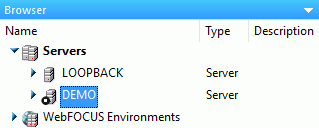
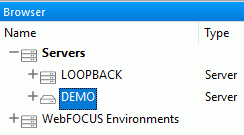
You can test the connection between the DMC and the DataMigrator Server you have added.
Procedure: How to Test the Server
Before you proceed, it is recommended to test the connection between the DMC and the DataMigrator Server.
To ensure that the server is running and that you are able to retrieve sample data:
- In the DMC, double-click the server name. If you can connect to the server, multiple folders, including Application Directories, Adapters, and others, open in the navigation pane.
- Expand the Application Directories folder.
If you can see the list of application directories, you are connected to the server.
| WebFOCUS | |
|
Feedback |